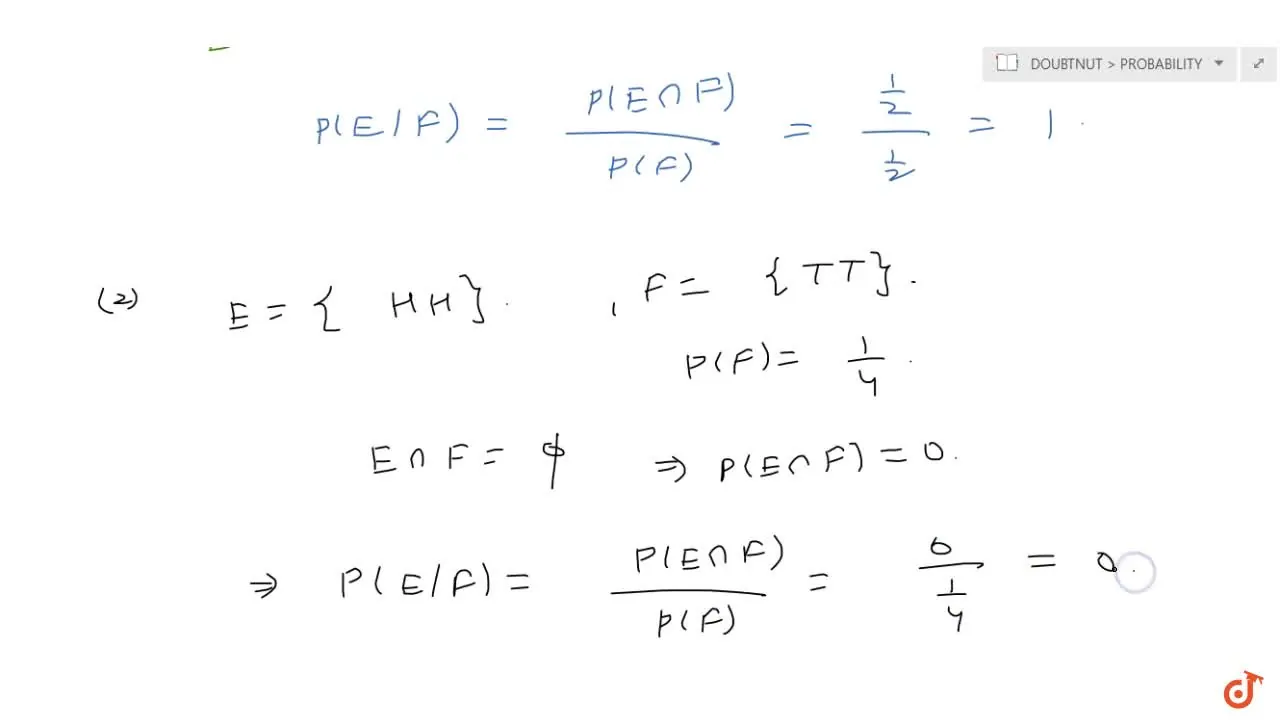Determine P(E∣F)in :Two coins are tossed once, where(i) E: tail appears on one coin, F : one coin shows head(ii) E : no tail appears, F : no head appears
The sample space S of an event where two coins are being tossed together is given by,
S={(H,H),(H,T),(T,H),(T,T)}
Here, the number of elements in the sample space S is,
n(S)=4
(i) E stands for "tail appears on one coin", i.e.,
E={(H,T),(T,H)}
And, F stands for "one coin shows head", i.e.,
F={(H,T),(T,H)}
∴E∩F={(H,T),(T,H)}
So, P(F)=24
⇒P(F)=12
And, P(E∩F)=24
⇒P(E∩F)=12
Thus, as it is known,
P(E∣F)=P(E∩F)P(F)
⇒P(E∣F)=1212
⇒P(E∣F)=12⋅21
⇒P(E∣F)=11
⇒P(E∣F)=1
(ii) E stands for "no tail appears", i.e.,
E={(H,H)}
And, F stands for "no head appears", i.e.,
F={(T,T)}
∴E∩F=∅
So, P(F)=14
And, P(E∩F)=04
⇒P(E∩F)=0
Thus, as it is known,
P(E∣F)=P(E∩F)P(F)
⇒P(E∣F)=014
⇒P(E∣F)=0⋅41
⇒P(E∣F)=0
Related Playlists
- BOOK - NCERTCHAPTER - PROBABILITYEXERCISE - MISCELLANEOUS EXERCISE19videos
PROBABILITY
- BOOK - NCERTCHAPTER - PROBABILITYEXERCISE - EXERCISE 13.515videos
PROBABILITY
- BOOK - NCERTCHAPTER - PROBABILITYEXERCISE - Solved Examples36videos
PROBABILITY
- BOOK - NCERTCHAPTER - MATRICESEXERCISE - EXERCISE 3.312videos
MATRICES
- BOOK - NCERTCHAPTER - RELATIONS AND FUNCTIONSEXERCISE - EXERCISE 1.314videos
RELATIONS AND FUNCTIONS
Similar Questions
Determine P(E∣F)in :Two coins are tossed once, where(i) E: tail appears on one coin, F : one coin shows head(ii) E : no tail appears, F : no head appears
View SolutionTwo coins are tossed once. Find P(AB) in each of the following : (i)A= Tail appears on one coin, B= One coin shows head. (ii)A= No tail appears, B= No head appears.
View SolutionDetermine P(E∣F)in :A coin is tossed three times, where (i) E : Head on third toss, F : heads on first two tosses(ii) E : at least two heads, F : at most two heads(iii) E : at most two tails, F : at least one tail
View SolutionTwo coins are tossed together. Find the probability that a tail will appear on both the coins.
View SolutionThree coins are tossed simultaneously . Find the probability that tail appears on the middle one.
View Solution(a) A coin is tossed three times.
(i) E : heads on third toss , F : heads on first two tosses
(ii) E : at least two heads,
F : at most two heads
(iii) E : at most two tails , F : at least one tail.
Find the probability in all cases.View SolutionA coin is tossed 5 times. The probability that tail appears an odd number of times, is:
View SolutionThree fair coins are tossed. If both heads and tail appear, then determine the probability that exactly one head appears
View SolutionTwo coins are tosses simultaneously. Find the probability of getting:
(i) one head
(ii) at least one head
(iii) no tailView SolutionTwo coins are tossed. What is the probability of getting 2 heads or 2 tails?
View Solution


